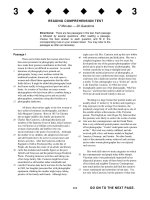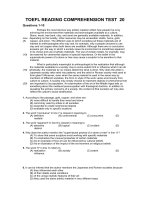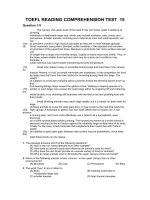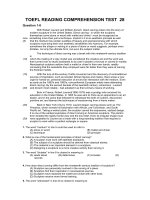TOEFL READING COMPREHENSION TEST 46
Bạn đang xem bản rút gọn của tài liệu. Xem và tải ngay bản đầy đủ của tài liệu tại đây (72.99 KB, 7 trang )
TOEFL READING COMPREHENSION TEST 46
Passage 1
Since there is such an abundance of food in the sea, it is understandable
that some the efficient, highly adaptable, warm - blooded mammals that evolved
on land should have returned to the sea. Those that did have flourished Within
about 50 million years - no time at all, geologically speaking - one of the four
kinds of mammals that has returned to a marine environment has developed into
the largest of all animal forms, the whale. A second kind, the seal, has produced
what is probably the greatest population of large carnivorous mammals on Earth.
This suggests that these "top dogs" of the ocean are prospering and multiplying.
However, such has not been the case, at least not for the last 150 years. Trouble
has closed in or these mammals in the form of equally warm-blooded and even
more efficient and adaptable predators, humans. At sea, as on land, humans
have now positioned themselves on to -of the whole great pyramid of life, and
they have caused serious problems for the mammals of the sea.
There is a simple reason for this. Marine mammals have the misfortune to
be swimming aggregates of commodities that humans want: fur, oil, and meat.
Even so, they might not be so vulnerable to human depredation if they did not,
like humans, reproduce so slowly. Every year humans take more than 50 million
tons of fish from the oceans without critically depleting the population of any
species. But the slow-breeding mammals of the sea have been all but wiped out
by humans seeking to satisfy their wants and whims.
1. Which of the following statements about marine mammals best expresses the main idea of
the passage
(A) They have their origins on land.
(B) They have evolved successfully but are now threatened by humans.
(C) They compete with one another for the ocean's food supply.
(D) They have many of the biological traits of humans.
2. What advantage did some land mammals gain by returning to the sea?
(A) Fewer predators exist in the sea. (B) More space is available in the
sea.
(C) There is a greater supply of food in the sea. (D) The climate is more hospitable
in the sea.
3. It can be inferred from the passage that during the last 150 years humans have
(A) constructed submarines
(B) learned how to swim
(C) threatened the existence of some marine mammals
(D) begun to harvest certain plants from the ocean as food
4. In line 14 the word "they" refers to
(A) marine mammals (B) commodities (C) humans (D) fur. oil.
and meat
5. Which of the following statements is supported by the passage?
(A) The whale's ancestors were driven into the sea by humans.
(B) The food supply of seals is being depleted by humans
(C) The whale evolved from a species of land - dwelling mammal.
(D) Whales are a more efficient and adapt-able species than humans.
6. It can be inferred from the passage that marine mammals are like humans in which of the
following ways".
(A) They survive despite changes in their metabolic rates.
(B) They reproduce slowly.
(C) They are prospering and multiplying.
(D) They are depleting the vegetation of the seas.
Passage 2
Of all the folk artists in the United States the most well known of the
twentieth century is certainly Grandma Moses-Anna Mary Robertson Moses
(1860 - 1961). She was also the most successful within her lifetime and her work
was reproduced on greeting cards and calendars and in prints. As with many folk
artists, her career as a painter started late in life, at the age of 67, but she
continued painting until her death at the age of 101, so her active painting life still
spanned over 34 years.
Her subjects are based on the New England countryside and evoke a
strong mood of nostalgia. Many of her early paintings are copies of, or use
sections from, prints by Currier and Ives that she then recomposed in her own
way. In her versions the figures became more stylized and the landscapes less
naturalistic. Her painting was preceded by the production of landscapes in
needlework, and it was only the onset of arthritis that forced the change of
medium. The images, however, continued the same, and she reexecuted some
of her needlework landscapes in paint at a later date.
From these early sources she then began to compose original paintings
such as Housick Falls. New York in Winter (1944) that relied on her surroundings
and her memories of country life and activities: these paintings display an ~
technical ability By the 1940's her work had become a marketable commodity
and collectors created a demand for her paintings.
Like many painters of the nineteenth and twentieth centuries. Grandma
Moses made use of photographs for information, for figures, for fragments of
landscape, and for buildings, but her work, especially that of her later years, was
not a slavish copying of these but compositions using them as source material.
Her output was prodigious, and consequently her work is of varying quality.
Although much of her public appeal is based on the emotive image of the
"Grandma" figure producing naive pictures of country life, her paintings place her
among the top folk painters of the nineteenth and twentieth centuries.
1. What is the main topic of the passage?
(A) The painting materials used by Grandma Moses
(B) The major artistic influences on Grandma Moses
(C) The folk art of Grandma Moses
(D) The life of Grandma Moses
2. According to the passage, Grandma Moses started her painting career
(A) without much success (B) in her sixties
(C) after much study (D) by producing greeting cards
3. Why does the author mention Currier and Ives in lines 8-9?
(A) They are folk artists
(B) They collected many of Grandma Moses' paintings
(C) They made calendars from Grandma Moses' landscapes
(D) Grandma Moses based some paintings on their work
4. According to the passage, Grandma Moses switched from needlework to painting because
of
(A) her desire to create landscapes (B) the public's interest in painting
(C) her need to make money (D) a physic condition that affected
her
5. The word "naive" in line 23 is closest in meaning to which of the following?
(A) Unsophisticated (B) Ignorant (C) Unspoiled (D)
Trusting
6. According to the passage, Grandma Moses based her painting on all of the following
EXCEPT
(A) photographs (B) her needlework (C) her family (D) prints
7. Where in the passage does the author mention when Grandma Moses became popularly
accepted?
(A) Lines 4 – 6 (B) Lines 10 – 12 (C) Lines 16 – 17 (D) Lines
21 – 24
Passage 3
In general, as soon as the newborn child's muscles, sense organs, and
nerves are fully formed, the child begins to use them. But much of the human
nervous system is not fully developed until the child is a year or two old, and
some parts, such as the corpus callosum, continue to mature for at least the next
20 years.
The general pattern of bodily development is from head to foot. Simple
skills, such as head movements, appear first because the structures that control
these skills are among the first to mature. More complex behavior patterns, such
as crawling, standing, and walking, come much later in the developmental
sequence than head movements do.
The motor centers in the brain are connected by long nerve fibers(usually
through one or more synapses) to the muscles in various parts of the body.
Since the head muscles are closer to the brain than are the foot muscles,
according to one theory, the head comes under the control of the motor centers
long before the feet do. The appearance of a new motor skill (such as crawling
and grasping) always suggests that a new part of the child's body has just
matured-that is, that the brain centers have just begun to control the muscles
involved in the new motor skill.
1. What is the author's main purpose in this passage?
(A) To describe how children crawl, stand, and walk
(B) To explain why some children are slow to develop
(C) To describe early physical development in children
(D) To explain the function of the corpus callosum
2. According to the passage, the corpus callosum is part of the human
(A) muscular system (B) digestive system
(C) circulatory system (D) nervous system
3. According to the passage, which of the following motor skills does an infant first develop?
(A) Moving the head (B) Crawling
(C) Controlling the arms (D) Kicking
4. According to the passage, we can tell that the child's brain centers have begun to control
new muscles when
(A) the child's brain matures (B) the child moves its body in new
ways
(C) long nerve fibers disappear (D) the child performs an acquired
skill more rapidly
Passage 4
By long-standing convention, all meteorites are assigned to three broad
divisions on the basis of two kinds of material that they contain: metallic nickel -
iron(metal) and silicates, which are compounds of other chemical elements with
silicon and oxygen. As their name suggests, the iron meteorites consist almost
entirely of metal. At the opposite extreme, the stony meteorites consist chiefly of
silicates and contain little or no metal. A third category, stony-irons, includes
those meteorites that contain similar amounts of metal and silicates. Since
meteoritic metal weighs more than twice as much as the same volume of
meteoritic silicates, these three kinds of meteorites can usually be distinguished
by density, without more elaborate tests.
The stony meteorites can also be subdivided into two categories by using
nothing more complicated than a magnifying glass. The great majority of such
meteorites are chondrites, which take their name from tiny, rounded objects -
chondrules - that occur in most of them and are among their most puzzling
features. The rest of the stony meteorites lack chondritic texture and are
therefore called achondrites. Achondrites vary widely in texture, composition, and
history.
Irons, stony-irons, chondrites, and achondrites are by no means equally
abundant among observed meteorites: chondrites are much more common than
all other kinds of meteorites put together. The irons, which are usually prominent
in museum displays, are really quite uncommon. Curators like to highlight iron
meteorites because many of them are large and their internal structure is
spectacular in polished, etched slices. A stony meteorite has a beauty of its own,
but it only appears under the microscope: to the unaided eye, stony meteorites
appear to be - indeed they are - rather homely black or gray rocks.
To go further with meteorite classification, it is necessary to be more
specific about the minerals that make up a meteorite: which silicates are present,
and what kind of metal? To answer these questions, one needs to see more
detail than is visible to the unaided human eye.
1. What is the passage mainly about?
(A) The formation of meteorites (B) Some recent meteorites
(C) The classification of meteorites (D) How meteorites are displayed
2. The word "elaborate" in line 9 is closest in meaning to which of the following.
(A) Natural (B) Detailed (C) Basic (D)
Proven
3. According to the passage, small, rounded objects can be found in what kind of meteorites?
(A) Irons (B) Chondrites (C) Stony-irons (D)
Achondrites
4. According to the passage, the spectacular meteorites usually found in museums are
(A) gray or black (B) generally small
(C) unimportant to science (D) fairly uncommon
5. The word it" in line 21 refers to
(A) beauty (B) meteorite (C) microscope (D) eye
6. ???
7. Where in the passage does the author suggest a means by which meteorites can be
differentiated?
(A) Lines 3-4 (B) Lines 7-9 (C) Lines 18 – 19 (D) Lines
20-22
Passage 5
National parties in the United States have generally been weak in structure
and wary of ideology. Many writers have said that American parties are the least
centralized in the world. However, the argument that parties have not
represented significant differences in policy can be pushed too far. For example,
in this century, at least, the Republicans have been more committed than the
Democrats to a market - oriented economy, while the Democrats have been
more prepared to use government to address economic problems. Within both
parties there has been wide variance on issues but in general the Republicans
have been the more conservative and the Democrats the more liberal.
Both parties, however, have resisted reducing these tendencies in their
social, economic, and moral belief systems to a rigid ideology. And neither, until
recently, vested much authority in its national party structure.
At state and local levels, on the other hand, party organizations often
achieved impressive levels of solidarity and internal discipline. Both Democrats
and Republicans maintained potent local political organizations in many cities
and states.
Whatever their merits or demerits, the traditional organizations went into
steep decline during the 1950's and 1960's. The Old organizations lost the ability
to maintain internal discipline The share of voters regarding themselves as
political independents, that is, people not affiliated with either of the major
parties, rose.
There were several reasons for the loss of effectiveness of the major party
organizations. Development of a welfare state administered by the federal
government established some of the services that had formerly been dispensed
by the organizations as political favors. As recent immigrants became more
educated they were less dependent on party workers. The inclusion of more
state employees under civil service protection dried up some of the old wells of
patronage. Growing unionization of public employees after 1960 struck an even
more serious blow at the patronage system. Television brought candidates into
voters' living rooms, thereby antiquating some of the communication and
education functions of party workers. Most of all, perhaps, the old tribal
differences associated with the parties began to seem irrelevant to members of
generations that sought fresh identities.
1. What does the passage mainly discuss?
(A) American political parties in the twentieth century
(B) The role of ideology in American politics
(C) The future direction of United States politics
(D) Differences between Republicans and Democrats
2. According to the passage, what is true of the major political parties in the United States?
(A) They are both generally conservative
(B) Party organizations have been stronger at the state level than at the national level
(C) Party organizations have increased their influence in recent years
(D) Democrats have been stronger than Republicans at the national level
3. The word "steep" in line 15 is closest in meaning to which of the following?
(A) characteristic
(B) unexpected
(C) sharp
(D) predictable
4. The passage mentions all of the following as causes of the decline of political organization
in the United States EXCEPT
(A) increased numbers of immigrants
(B) development of the welfare state
(C) improved conditions for state workers
(D) the influence of television
5. The passage supports which of the following conclusions?
(A) Democrats are more committed than Republicans to a market - oriented economy
(B) Republicans are more liberal than Democrats
(C) Republicans and Democrats tend to be flexible on ideological questions
(D) Only Democrats have traditional political organizations
6. The word "irrelevant" in line 28 is closest in meaning to
(A) unquestioning (B) uninteresting
(C) irreversible (D) unimportant









